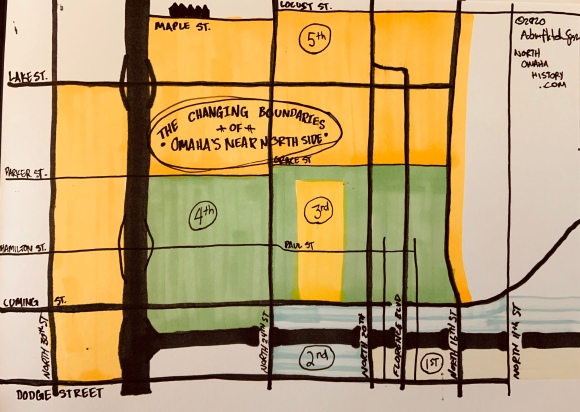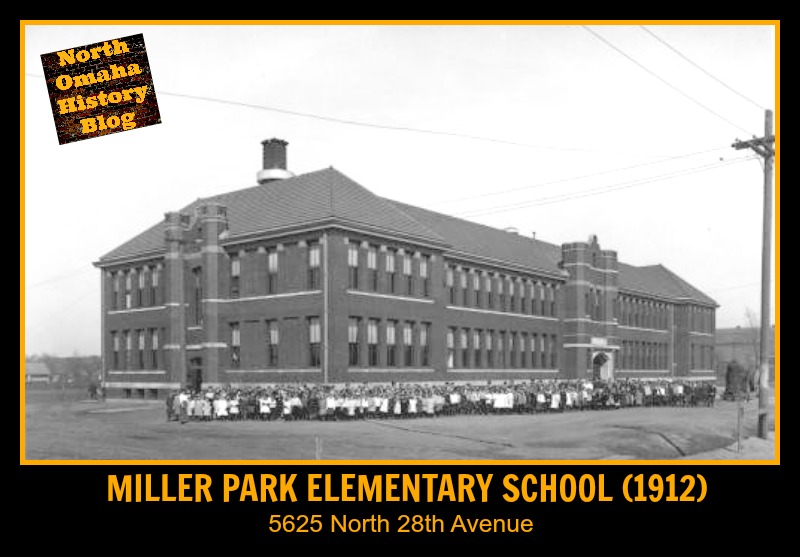For a century, North Omaha was home to many of Omaha’s Jews, including distinct synagogues for Germans and Russians. However, there were enough Hungarian Jews in Omaha to warrant their own social hall. This is a history of the Hungarian community in North Omaha.
Moving to Omaha
Hungarian immigrants probably started moving to Omaha soon after the city was founded in 1854. They were mostly Catholics and Jews, oftentimes undereducated workers from the countryside, and usually came without money.
Arriving in 1867, Adolph Gladstone was one of the first successful Hungarian Jews in Omaha. Starting around 1870, the Omaha chapter of the American-Hungarian Federation operated for several decades, meeting both on South 13th Street and on Cuming Street. Claiming 150 members in Omaha in 1912, this federation claimed it was “the largest and oldest known Hungarian organization in the United States” with 60,000 members nationally.
“…the city to casual investigation seemed to be populated entirely by Germans, Poles, Slavs, Hungarians, Croats, Magyars, and all the scum of the Eastern European States…”
-Rudyard Kipling wrote of Omaha in 1899
After the turn of the 20th century, Hungarian immigrants to the U.S. landed on Ellis Island and often settling in New York City, Hungarian immigrants often traveled by railroad to the middle of the country. In Omaha, they found a settlement of Jews who responded to American discrimination by establishing their own community fixtures and taking care of their own with employment and opportunities.
Little Hungary?

Although it wasn’t referred to as such, the area around North 19th and Cuming Street could have been called Little Hungary. Most of the city’s Hungarians lived in that neighborhood, which was a residential area then called the Near North Side, and now the present-day North Downtown near the Cass Street School, the Union Pacific Shops, and several stores and other amenities neighbors needed. They lived next to several other immigrant communities in the area, including Italians, Chinese, Scandinavians and others. The city’s early African American neighborhood was also there from the 1870s through the 1910s. In this neighborhood, there were Hungarian grocery stores and shops, a synagogue.
Bikur Cholim was organized in 1885 by Omaha’s Hungarian Jews. A charitable society, they helped sick and dying members as well as holding weekly and high holiday services. Around the time they organized, Chevra Bikur Cholim acquired a tract they called Pleasant Hill Cemetery at North 42nd and Redick. Eventually holding 642 graves, the B’nai Jacob tract at Pleasant Hill was made part of the Temple Israel Cemetery.

In the 1890s, many Hungarian Catholics worked in the UP shops and lived in the neighborhood, and started attending Holy Family Catholic Church at North 17th and Izard Streets.
In 1896, the Bikur Cholim changed its name to the Hungarian Society.
Since before the turn of the century, a Hungarian synagogue met on North 19th Street between Burt and Webster. Organized by Jacob Klein, it was originally called B’nai Jacob Ohave Sholem, or “Children of Jacob-Lovers of Peace.” However, within its first year the name was soon changed slightly to B’nai Jacob Anshe Sholem, or Children of Jacob-Men of Peace.
As the community moved, B’nai Jacob Anshe Sholom moved several times, with their first synagogue at North 22nd and Cuming Street, a second at North 24th and Nicholas Street, then a third at 6412 North 42nd Street. This congregation was also called the Kapulier Shul.
The 1910 US Census counted 3,414 “Austrian-Hungarians” in Omaha, which included Croats.
During this time, it was known that some non-religious Hungarians were settling in Omaha, including starting truck farms in East Omaha.
A Hungarian Hall was originally planned to be built in 1910 on the same street. There were lavish fundraising costume ball held, but nothing came of it. Instead, the community kept renting out halls downtown for a variety of events, including an annual formal called the Hungarian Ball. These events were meant to reaffirm community bonds, ensure mutual success, and support new immigrants to America who lived in Omaha.
When World War I broke out in 1914, Omaha’s Hungarian population made loud pronouncements in the local newspapers about their loyalty to Hungary and willingness to go fight for their country.
Predicting their own demise, in 1918 the Hungarian Society changed its name to the Liberty Society of Omaha.
Around 1920, the Hungarian Social Club opened at N. 22nd and Cuming Streets. Political meetings, social events, and cultural activities were held there for several years. Large “fancy dress” parades were held by the community that included “the fantastically gaudy garb of the Hungarian peasant in the habiliments of the cowboy of the west, while ordinary ball room attire was relieved by the uniforms of the army, police and firefighters.” Hungarian bands regularly played Hungarian music to celebrate, entertain and uplift the community at the social hall.
In 1925, a pair of Hungarian Jewish brothers started the Hinky Dinky grocery store chain in Omaha. The Newmans eventually opened at least a dozen grocery stores in North Omaha.
Twenty years later in 1940, the American-Hungarian Hall was opened at 1623 Cuming Street. It was opened in the renovated former Swanson Building, which housed the first offices and factory of Carl Swanson. Swanson was a Swedish immigrant who revolutionized the food industry by inventing Swanson frozen dinners. His building was located in the original Little Stockholm neighborhood. By the 1930s, most of the Swedes had moved from the neighborhood and there were few Swedish immigrants coming to Omaha.
A New Hall During WWII

However, starting in that era Hungarian Jews and Catholics were pouring into Omaha as they fled from Hitler’s Nazi genocide. In late 1939, they bought the Swanson building and quickly remodeled it extensively. On January 21, 1940, they held a grand opening of the new Hungarian Hall at 1623 Cuming Street. Their new hall featured a main floor auditorium and stage, meeting rooms, a kitchen, banquet hall and caretaker’s quarters on the second floor.
Owned by the American-Hungarian Cultural and Education Society, many Hungarians in Omaha worked together to open the facility. Alternately referred to as the American-Hungarian Hall, the Hungarian Community Center and the Hungarian Home, the building morphed over the decades, and in its last form was a senior retirement home. However, in the few decades after it opened the Hungarian immigrant population in Omaha assimilated into mainstream culture and was welcomed in the larger community. Along the way, the surrounding area around the hall became more industrial.
Assimilating Populations
The last mention of the hall was in 1975. Afterwards, the building became the Aero Apartment-Hotel. It was razed after 2011, and today there’s no evidence it ever existed.
Today there is little evidence of Omaha’s rich Hungarian heritage. Saints Peter and Paul Catholic Church makes a strong claim as the historic home of the community, along with several other Eastern European nationalities. Located in south Omaha, it probably had little to do with the community on the northside though. A few bars claim to have authentic Hungarian goulash, but I haven’t found any recent celebrations of Hungarian culture in Omaha.
Aside from the original Hungarian Jew gravesites at Temple Israel Cemetery, today there is virtually no trace of Omaha’s Hungarian immigrant community.
If you know more about North Omaha’s Hungarian community, please leave a comment or send at email to info @ northomahahistory .com.
You Might Like…
MY ARTICLES ABOUT THE HISTORY OF OMAHA’S NEAR NORTH SIDE
GROUPS: Black People | Jews and African Americans | Jews | Hungarians | Scandinavians | Chinese | Italians
EVENTS: Redlining | North Omaha Riots | Stone Soul Picnic | Native Omaha Days Festival
BUSINESSES: Club Harlem | Dreamland Ballroom | Omaha Star Office | 2621 North 16th Street | Calhoun Hotel | Warden Hotel | Willis Hotel | Broadview Hotel | Carter’s Cafe | Live Wire Cafe | Fair Deal Cafe | Metoyer’s BBQ | Skeet’s | Storz Brewery | 24th Street Dairy Queen | 1324 N. 24th St. | Ritz Theater | Alhambra Theater | 2410 Lake Street | Carver Savings and Loan Association | Blue Lion Center | 9 Center Variety Store | Bali-Hi Lounge
CHURCHES: St. John’s AME Church | Zion Baptist Church | Mt. Moriah Baptist Church | St. Philip Episcopal Church | St. Benedict Catholic Parish | Holy Family Catholic Church | Bethel AME Church | Cleaves Temple CME Church | North 24th Street Worship Center
HOMES: A History of | Logan Fontenelle Housing Projects | The Sherman | The Climmie | Ernie Chambers Court aka Strelow Apartments | Hillcrest Mansion | Governor Saunders Mansion | Memmen Apartments
SCHOOLS: Kellom | Lake | Long | Cass Street | Izard Street | Dodge Street
ORGANIZATIONS: Red Dot Athletic Club | Omaha Colored Baseball League | Omaha Rockets | YMCA | Midwest Athletic Club | Charles Street Bicycle Park | DePorres Club | NWCA | Elks Hall and Iroquois Lodge 92 | American Legion Post #30 | Bryant Resource Center | People’s Hospital | Bryant Center
NEIGHBORHOODS: Long School | Logan Fontenelle Projects | Kellom Heights | Conestoga | 24th and Lake | 20th and Lake | Charles Street Projects
INDIVIDUALS: Edwin Overall | Rev. Russel Taylor | Rev. Anna R. Woodbey | Rev. Dr. John Albert Williams | Rev. John Adams, Sr. | Dr. William W. Peebles | Dr. Craig Morris | Dr. John A. Singleton, DDS | Dr. Aaron M. McMillan | Mildred Brown | Dr. Marguerita Washington | Eugene Skinner | Dr. Matthew O. Ricketts | Helen Mahammitt | Cathy Hughes | Florentine Pinkston | Amos P. Scruggs | Nathaniel Hunter | Bertha Calloway
OTHER: 26th and Lake Streetcar Shop | Webster Telephone Exchange Building | Kellom Pool | Circus Grounds | Ak-Sar-Ben Den
Elsewhere Online
- “Hebrew Text Bylaws of Congregation B’nai Jacob Ohave Sholom,” American Jewish Archives (1984).






Leave a comment